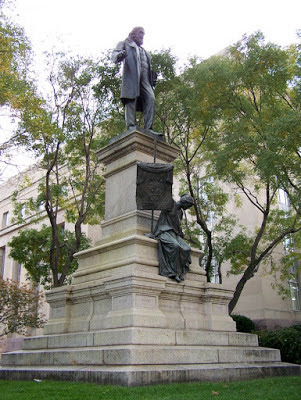by Christopher Hodapp
Fox5 TV in Washington, D.C. is reporting late Friday night that the bronze statue of Albert Pike in Judiciary Square has just been toppled and burned. Between 80 and 100 people were gathered around the statue shortly after 11PM when it was yanked off its pedestal and knocked to the ground. Once on the ground, the cheering crowd reportedly attempted to set fire to to it (a forlorn waste of time and lighter fluid, as the bruised and battered bronze figure stubbornly refused to burn, proving its tormentors all flunked out of high school chemistry class).
There really should be no surprise, since Popular Mechanics magazine helpfully published an article online earlier in this week that was a How-To Guide to toppling or otherwise destroying statues anyone finds offensive.
News reports this evening continue to characterize Pike's sculpture as a "Confederate monument," despite the fact that it was never anything of the kind. His statue was not erected by pro-Confederate veterans groups, or by alleged Ku Klux Klan members (it predated the 1920s resurgence of the KKK by many years). The 11-foot tall bronze sculpture by Italian artist Gaetano Trentanove, towering high above its massive limestone plinth, was erected in 1901 and donated to the city by the Scottish Rite Southern Jurisdiction to commemorate their own 100th anniversary. It's location marked the former home of the AASR's headquarters for its first 90 years.
There are (or were) eight inscriptions around the corners of its granite base: Author, Poet, Scholar, Soldier, Philanthropist, Philosopher, Jurist, and Orator. On the front was a Latin phrase, Vixit Laborum Ejus Super Stites Sunt Fructus. ("He has lived. The fruits of his labors live after him.") Despite the fact that detractors objected to it on the grounds that Pike had served for just five months in the Confederate Army before resigning in disgust, making it the only statue of a former Confederate soldier in the District, the sculpture did NOT depict him as a Confederate soldier. There were no references to the Confederacy anywhere to be found (not even symbolically), and the banner in the hand of the Grecian figure is not a Confederate flag or symbol, but a Scottish Rite one featuring the double-headed eagle. It was purely a Masonic statue.
 |
| Before it fell to the mob |
Pike's statue has been considered 'controversial' since 1989 when famed whacko Lyndon Larouche first raised a stink over it. The most recent attempts by Washington DC's non-voting delegate to Congress, Eleanor Holmes Norton to have it removed used all of the same (and more) false accusations and outright fabrications that ignored the volumes of truthful information available about the life of Albert Pike and his accomplishments. Despite allegations by conspiracists and activists, there has never been any proof that Pike had written the rituals of the Ku Klux Klan, or had anything to do with the post-Civil War Klan. For more than you'd ever want to know about this, have a look at previous articles:
Oh, what's the use? Mobs can't be reasoned with, and history doesn't matter anymore. So now that Albert's figure has been dashed to the ground, I suppose it can't be 'controversial' anymore. It is perhaps best that the argument about the statue is finally at an end. Freemasonry must not be the cause of division or controversy, among ourselves or the community in which we reside. Pike would agree, were he here today.
The statue was originally bought and paid for by the Scottish Rite, but it was handed over to the National Park Service shortly after it was erected. It will be up to them to decide the fate of what remains cometh the dawn, since it is Federal property on Federal land (you can bet no one will be charged with destroying Federal property). I'm sure Pike himself would have waxed philosophical about the whole affair – he actually didn't want any monuments to himself after he died, hoping his life's works would stand or fall as his epitaph, letting history judge his worth. But it's tough to simply shrug this off as we watch events unfold in real time.






Explaining Pike's several careers and very complicated biography is not easy when things get to this point. It perhaps hasn't helped to have President Trump enter the scene as he has with his twitters chastising Mayor Browser about the pulling down.
ReplyDeleteAgreed!
DeleteFor years, many AASR Brothers have pointed out things to the effect of "isn't it interesting that the only statue of a Confederate on federal property is this one?"
ReplyDeleteChickens.
Roost.
Pike himself did not want a statue erected to his memory - the Supreme Council ignored his wishes.
The dramatic assault on the statue has predictably precipitated a torrent of less than scholarly explanations as to who he was. They are not calm and measured appreciations. Typical:
ReplyDelete"Albert Pike was a Confederate War General. During the conflict, Pike was accused of using native Choctaw Indian warriors to take the scalps of slain Yankee soldiers. He would feast his soldiers and the Indians with wagons filled with bawdy whores and ply them with liquor.
President Abraham Lincoln declared rebel Pike a criminal menace and sought to capture and imprison the corrupt General. When the war ended, Pike immediately fled to the safety of neighboring Canada. Some believe that Albert Pike was involved in the conspiracy and plot to murder Lincoln. Nevertheless, he was pardoned after the war by Lincoln’s successor, President Andrew Johnson, a southerner.
Albert Pike: Sovereign Grand Commander of the Masonic Lodge
Back home in South Carolina, Pike was chosen to become the top Mason in America as Sovereign Grand Commander of Scottish Rite Freemasonry. Pike, an academic and a poet (He wrote the famous song, Dixie), rewrote the 33 degree rituals still used up to this day."
Just where the correspondent found his evidence of the bawdy wagons of sin or of Pike helping the plotters of Lincoln's death will remain a mystery because there is not anything to substantiate the canards.
Perhaps more important is that the comments produced by this latest incident will get repeated endlessly. The exhumation years ago of Pike's body and then his re-burial in a central vault on the grand staircase of the House of the Temple in retrospect is not helpful as we try to go forward. It perhaps wasn't such a good idea.
Bro. Paul Rich,
DeleteYou offer no references backing your accusations that Bro. Pike ordered scalping and furnished "wagons full of liquor and bawdy whores". I would be interested in any documented references you have if you will furnish them.
The American Battlefield and Trust preserves America's hallowed battlegrounds and educates the public about what happened there and why it matters. May I refer you to the following page:
https://www.battlefields.org/learn/articles/cherokees-pea-ridge
in which the American Battlefield and Trust offers documentation entitled "Cherokees at Pea Ridge" that you may educate yourself on what really happened at the Battle of Pea Ridge on March 7-8 in 1862. You may find paragraph eight of particular interest.
Sincerely,
-Watchful MM
Bro. Paul Rich,
DeleteIn my frustration and anger upon reading the news of the statue toppling, I misread your post above and responded. This morning, with fresh eyes and rested mind, I see I have taken your post totally out of context and have opened my mouth only to insert my foot.
I take full responsibility for my comment and openly apologize to you, Sir.
Sincerely,
-Watchful MM
I wasn't asserting either. Kindly reread.
DeleteThank you, further to my previous reply, I looked carefully at the Pea Ridge article. Although it is not sourced at all, it certainly acknowledges as I think everyone does that Pike was the commanding officer during the scalpings.
DeleteIt gives little on the scalpings, which could arouse attention because of the failure to recover the scalps and the observation that initial scalpings could take something of the head so there would be material to work on in finishing the trophy. Pike did not apparently attempt to recover the remains from those under his command who had done the scalpings. In any event, my initial comment was to criticize statements about his military career as unsubstantiated and I questioned them. The scalpings and other aspects of his military service are perhaps not gat all germane to the use put of Pike in Masonry.
My own observation would be that Morals and Dogma generally offers no bibliography or sources and in any case modern archeological and mythological studies have moved far beyond what was available to him. To my knowledge there are no courses at any college or university which use him as a reference nor would a paper citing him on those fields be acceptable. His views, such as the Biblical John being an Essenian adviser to King Herod, etc. are somewhat remarkable.
And there are questions about his attitudes. In 1875 (note, 1875)in a letter he wrote:
"I am interested to keep the Ancient and Accepted Rite uncontaminated, in our country at least, by the leprosy of negro association. Our Supreme Council can defend its jurisdiction, and it is the law-maker. There can not be a lawful body of that Rite in our jurisdiction unless it is created by us.Our Supreme Council can defend its jurisdiction, and it is the law-maker. There can not be a lawful body of that Rite in our jurisdiction unless it is created by us."
In "A Critical Examination of Objections to the Legitimacy of the Masonry Existing Among the Negroes of America" by William H. Upton, 1902, p.214-15.
I'm a Freemason, and my views about this are mixed. On one hand, the statute didn't honor the Confederacy, but other aspects of this illustrious individual. On the other hand, I regarded the statue as gaudy and Pike himself as something of a mixed bag. I would deplore anyone thinking that regional identity mattered more than ending slavery, and for that reason regard Bro. Pike's Confederate service as a demerit.
ReplyDeleteAllegedly the reason he was dug up, rehoused so to speak, and given a shrine for his bones on the staircase was so that another supreme commander could have a matching tomb inside the House of the Temple, which was done. As with the incredibly amateurish portraits of donors that have proliferated, the "improvements" are questionable. Pike's original headstone is still at Lot 541 East in Oak Hill Cemetery inn. Georgetown, sometimes adorned with a sign "Pike has taken a hike." All this has created the widespread erroneous impression that the House of the Temple is Pike's tomb, when in fact only a small part of it is. A public relations move would be putting Pike back in Oak Creek.
DeleteOne recalls Washington skirted eternal rest in the Capitol rotunda and as he specified in his will is at Mount Vernon. The space two stories below the rotunda remains empty and the glass floor intended to give glimpses from the Rotunda of Washington's bier was never installed. Pike wished to be cremated and scattered, but so much for parting wishes.
Wow. I never knew he resigned from the Confederate army in disgust. I planned on going through the Scottish Rite in Savannah GA but covid got in the way and they did it today actually but I had to work. I hope to do it next time they meet and learn more about his works and not hearsay.
ReplyDeleteTruth & facts are not relevant to any group whose actions motivated primarily by passionate emotion.
ReplyDeleteAbsolutely disgraceful. Similar scum defaced a monument to Gen Grant along with other statues in San Francisco. These morons even defaced a monument to Miguel Cervantes, the man who wrote Don Quixote. Cervantes died in 1610 and had nothing to do with slavery. Stupidity reigns.
ReplyDeleteWe have learned not put anything on government land. If Mayors and governors allow punks to freely damage anything they please.
ReplyDelete